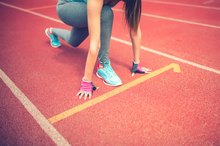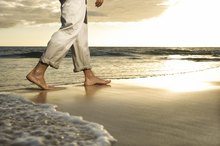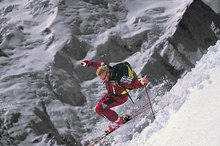Cycling & Pulled Calf Muscles
About 86 million Americans cycle, including 40 percent of adults, according to the Outdoor Industry Association. Cycling provides medical and social benefits, such as improved cardiovascular health, weight control and a stronger family bond. Cycling is also appealing if you’re searching for a low-impact exercise. However, it can lead to injuries such as a pulled calf muscle.
What Is a Pulled Calf Muscle?
Soft tissue injuries, such as a pulled or strained calf muscle, are common types of cycling injuries. The calf muscle group consists of three muscles -- the gastrocnemius, soleus and plantaris. Calf muscle strains most commonly affect the gastrocnemius. They occur when the muscle stretches too much or tears.
- Soft tissue injuries, such as a pulled or strained calf muscle, are common types of cycling injuries.
- Calf muscle strains most commonly affect the gastrocnemius.
Causes and Risk Factors
Knee Injuries & Sprinting
Learn More
A variety of factors can contribute to a calf muscle strain, including weakness of the muscles, improper warm-up and cycling too much in one day. Your form or technique during cycling can also cause a calf strain, such as if your foot is pointing upward and your calf muscle is hyperextended at the lowest cycle position. Tight muscles, cold weather and fatigue are also possible causes of calf muscle strain.
Bike Fit, Technique and Resistance
Ensuring that your bike is properly fitted can reduce your risk of pulling a calf muscle. The seat should be at the correct height so you don’t hyperextend your calf muscle when pedaling. Your feet should be pointing forward as you cycle, not upward. Also, cycle at a resistance or gear you can manage. If the gear is too high, you’ll have to push down more forcefully with your foot and possibly overexert or strain your calf muscle.
- Ensuring that your bike is properly fitted can reduce your risk of pulling a calf muscle.
- The seat should be at the correct height so you don’t hyperextend your calf muscle when pedaling.
Muscle Protection
Stretching Exercises for ACL Injuries
Learn More
Stretching your calf muscles helps to increase flexibility and prevent muscle strains. Always warm up before you stretch your calf muscles, either by walking or cycling at a slow pace for about five to 10 minutes. To begin a simple calf stretch, stand with your hands against a wall. With your right knee slightly bent, stretch your left leg out behind you and press your heel into the floor. Hold the stretch for 15 to 30 seconds. Return to the starting position and repeat with your other leg. Repeat the stretch on both legs.
- Stretching your calf muscles helps to increase flexibility and prevent muscle strains.
- To begin a simple calf stretch, stand with your hands against a wall.
Treatment
Treat a mild to moderate calf muscle strain with RICE -- rest, ice, compression and elevation -- when you first suffer the injury. Take a break from cycling until the pain and swelling subside. Ice your calf for 15 to 20 minutes about four times a day. Keep your leg elevated as often as possible. After three to five days, you can begin to apply heat to speed the healing process. Once you’re no longer experiencing acute pain, begin gentle stretches for about 10 seconds, four to six times a day. If you experience symptoms such as bruising on your calf or your calf muscle balling up, you likely have a severe or Grade III strain. Seek medical attention as soon as possible.
- Treat a mild to moderate calf muscle strain with RICE -- rest, ice, compression and elevation -- when you first suffer the injury.
Related Articles
References
- “Current Reviews in Musculoskeletal Medicine”; Gastrocnemius vs. Soleus Strain: How to Differentiate and Deal With Calf Muscle Injuries; J. Bryan Dixon; June 2009
- The Doctors of USC; Calf Muscle Strain; Laurie LaRusso, MS, ELS
- “Heal Your Knees”; Robert Klapper, M.D. and Lynda Huey; 2004
- Bryan Dixon J. Gastrocnemius vs. soleus strain: how to differentiate and deal with calf muscle injuries. Curr Rev Musculoskelet Med. 2009;2(2):74-7. doi:10.1007/s12178-009-9045-8
- Dixon JB. Gastrocnemius vs. soleus strain: how to differentiate and deal with calf muscle injuries. Current Reviews in Musculoskeletal Medicine. 2009;2(2):74-77.
Writer Bio
Kay Uzoma has been writing professionally since 1999. Her work has appeared in "Reader’s Digest," "Balance," pharmaceutical and natural health newsletters and on websites such as QualityHealth.com. She is a former editor for a national Canadian magazine and holds a Bachelor of Arts in political science from York University.









